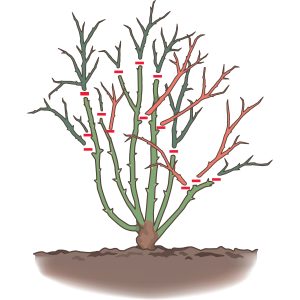“The Art of Winter Pruning: A Guide to Keeping Your Roses Beautiful and Healthy”
Winter is a season of dormancy for many plants, but it’s also the perfect time to give your roses some much-needed care and attention. While the thought of pruning your beloved rose bushes during the cold months may seem counterintuitive, winter pruning is an essential step in maintaining their health and beauty. In this blog post, we’ll explore the art of winter pruning for roses and provide you with expert tips to ensure your garden blooms with vibrant roses come spring.
Why Winter Pruning?
1. Promotes Growth and Flowering:
Winter pruning encourages new growth by stimulating the production of buds. When spring arrives, your roses will burst with fresh shoots and vibrant blooms.
2. Disease Prevention:
Removing dead or diseased wood during winter helps prevent the spread of fungal infections and pests, ensuring the overall health of your rose bushes.
3. Shape and Structure:
Winter pruning allows you to shape your rose bushes, ensuring an open and balanced structure that allows for good air circulation and sunlight penetration.
Steps to Successful Winter Pruning:
1. Gather Your Tools:
Before you start, make sure you have the right tools, including sharp pruning shears, loppers, gloves, and safety glasses.
2. Identify Dead or Diseased Wood:
Begin by inspecting your rose bushes for dead or diseased branches. These should be removed entirely, cutting back to healthy wood.
3. Cut at a 45-Degree Angle:
When making your cuts, do so at a 45-degree angle just above an outward-facing bud. This angle helps water run off the cut and encourages growth away from the center of the bush.
4. Remove Weak or Crossing Branches:
Eliminate weak or crossing branches to improve the overall structure of the plant. This ensures better air circulation and reduces the risk of diseases.
5. Maintain an Open Center:
Aim for an open center to allow sunlight to reach all parts of the bush. This reduces the risk of fungal infections and encourages even growth.
6. Prune for Size:
Consider the size of your rose bushes and prune accordingly. For larger varieties, prune more, but be careful not to cut too much from smaller or miniature roses.
7. Clean Up Debris:
After pruning, remove all the debris from around your rose bushes to prevent the spread of diseases.
8. Mulch and Feed:
Finish by applying a layer of mulch around the base of your roses to help retain moisture and protect against winter frost. You can also provide them with a balanced fertilizer to nourish the soil.
Winter pruning may seem like a daunting task, but it’s a vital part of rose care that will reward you with healthier, more vibrant blooms when spring arrives. By following these steps and giving your roses the attention they deserve during the colder months, you’ll ensure a stunning and flourishing rose garden for years to come. So, bundle up, grab your pruning shears, and embrace the art of winter pruning to keep your roses at their best.

